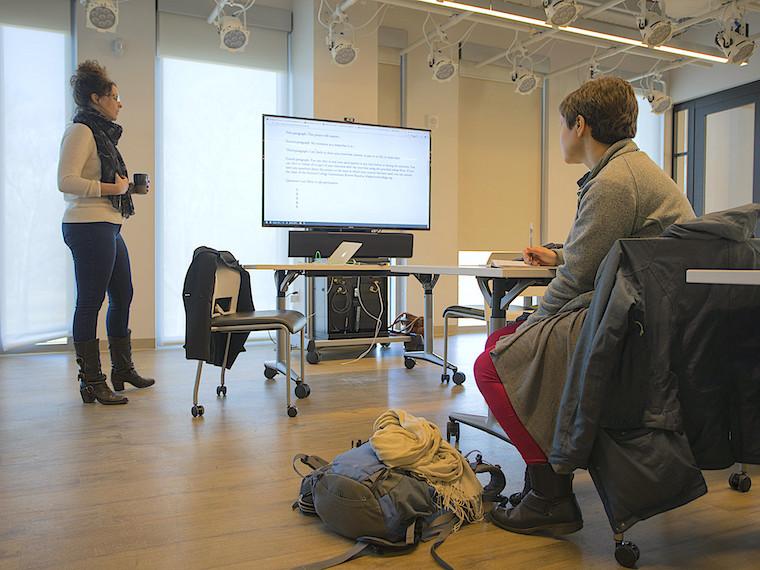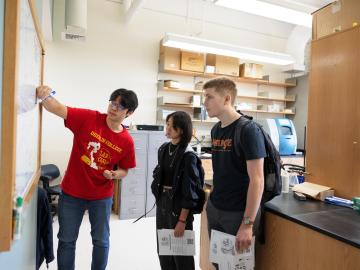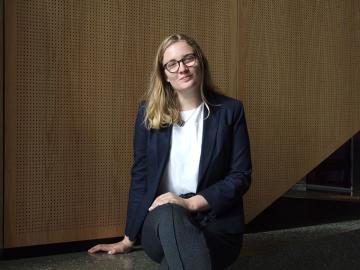The Lives of African American Women are Shared in a History Design Lab Project
December 2, 2021
Yvonne Gay

A history project moves from the classroom to an ongoing digital platform that focuses on the lives of extraordinary African American women closely associated with the college.
After graduating from Oberlin College in 1957, Sylvia Hill Williams played a key role in moving the presentation of African art away from stereotypical displays to scholarly nuanced exhibits at the Smithsonian National Museum of Natural History. In her role as an archivist, Ruth Anna Fisher, a 1906 Oberlin graduate, produced knowledge about Black history within a space traditionally dominated by white men.
Their stories, and those of other women, are explored in the History Design Lab project’s African American Women Intellectuals (AAWI).
The History Design Lab, an initiative of the Department of History, is a collaborative community of students, faculty, and staff who work on original research-based history projects. Lab members discuss new ideas and explore how resources and methods can be used to reimagine the way history is engaged by the viewer. The lab currently oversees three projects: On Second Thought, a student historical blog and journal; Oberlin History as American History; and the AAWI project.
The AAWI project arose from a spring 2020 Research Methods in Black Women’s Intellectual History course. The final project of the course evolved into a digital web page which then gave rise to a History Design Lab project.

Currently, AAWI features 12 Black women in 12 separate exhibits. An “item” tab provides detailed information about archival material presented, and all of the exhibits are categorized by centuries.
“Rather than just focus on the women themselves as a typical biography would, AAWI’s scholarly biographies center more on the scholarly and intellectual work of these Black women, such as their theses, operas, and speeches,” says Meredith Warden ’23, a biography contributor and associate editor of both AAWI and On Second Thought projects.
For instance, the AAWI biography on Rhiannon Giddens ’00 centers largely around the musician’s own research of the banjo. “The history of the banjo [brought to America by enslaved African people but commercialized by white minstrel musicians] is complex, painful, and necessary to uncover and share,” writes biography author, Ella Causer ’21. “Giddens currently sees uncovering the banjo’s history as her life purpose.” As Causer continues, Giddens’s biography is told through sections that delve into her opera studies and MacArthur Award.
“As with any history-based project, the primary sources only tell so much about the person and their motivations, thoughts, and feelings,” explains Warden. “This was definitely a challenge while I was reading primary sources written by the person my biography focused on and deciding what narrative I was going to tell about her intellectual work. But that’s what I love about historical research—there are so many different ways to interpret these primary sources. The possible narrative I see in this woman’s work would probably not be the same as what someone else would see. Ultimately, [collaborating with] other people can help determine whether the narrative of a scholarly biography is compelling.”
Emily Spezia-Shwiff ’21, who graduated from Oberlin with majors in history and musical studies and a minor in gender, sexuality, and feminist studies, welcomed the space the History Design Lab and AAWI provided. As a former senior editor of the AAWI project and biography contributor, Spezia-Shwiff credits the AAWI project with allowing her to develop research, writing, and pedagogical skills, while teaching her how to disseminate information on complicated historiography, narrow wide ideas into compelling research topics, and work within someone else’s writing style to provide constructive feedback and edits.
“One of my favorite parts of studying history is uncovering and telling narratives that have been ignored and neglected,” says Spezia-Shwiff. “ I decided to take on this project because I wanted to continue highlighting these stories and create a large database of Black women intellectuals.”
Spezia-Shwiff hopes visitors to the site will be encouraged and inspired as well.
“I hope viewers will ponder what it means to be a Black women intellectual,” says Spezia-Shwiff. “I hope these narratives will inspire viewers and encourage them in their own avenues. I encourage potential viewers to think critically about their view of history, [and ask]: Who is being left out of popular narratives? What stories may be lost or hidden throughout history?”
In January, the History Design Lab will offer a Winter Term component, where participants will learn the basics of digital humanities tools, perform research in Oberlin’s archives, and produce a piece of work as part of one of HDL’s current projects.
Tags:
You may also like…
Friday Afternoon with Lab Crawl
October 30, 2023
This year’s Lab Crawl drew what may be the largest crowd in the event’s illustrious history, with some 500 students and dozens of faculty taking part. Missed out on the excitement? It looked something like this.
Lab Crawl: It’s Not Just for Scientists
October 24, 2023
Oct. 27 open house highlights research across the sciences—and just about everywhere else.
In the Path of Disaster
August 28, 2023
Monica Dix travels to a hub of natural calamity to probe its risks and resilience.


